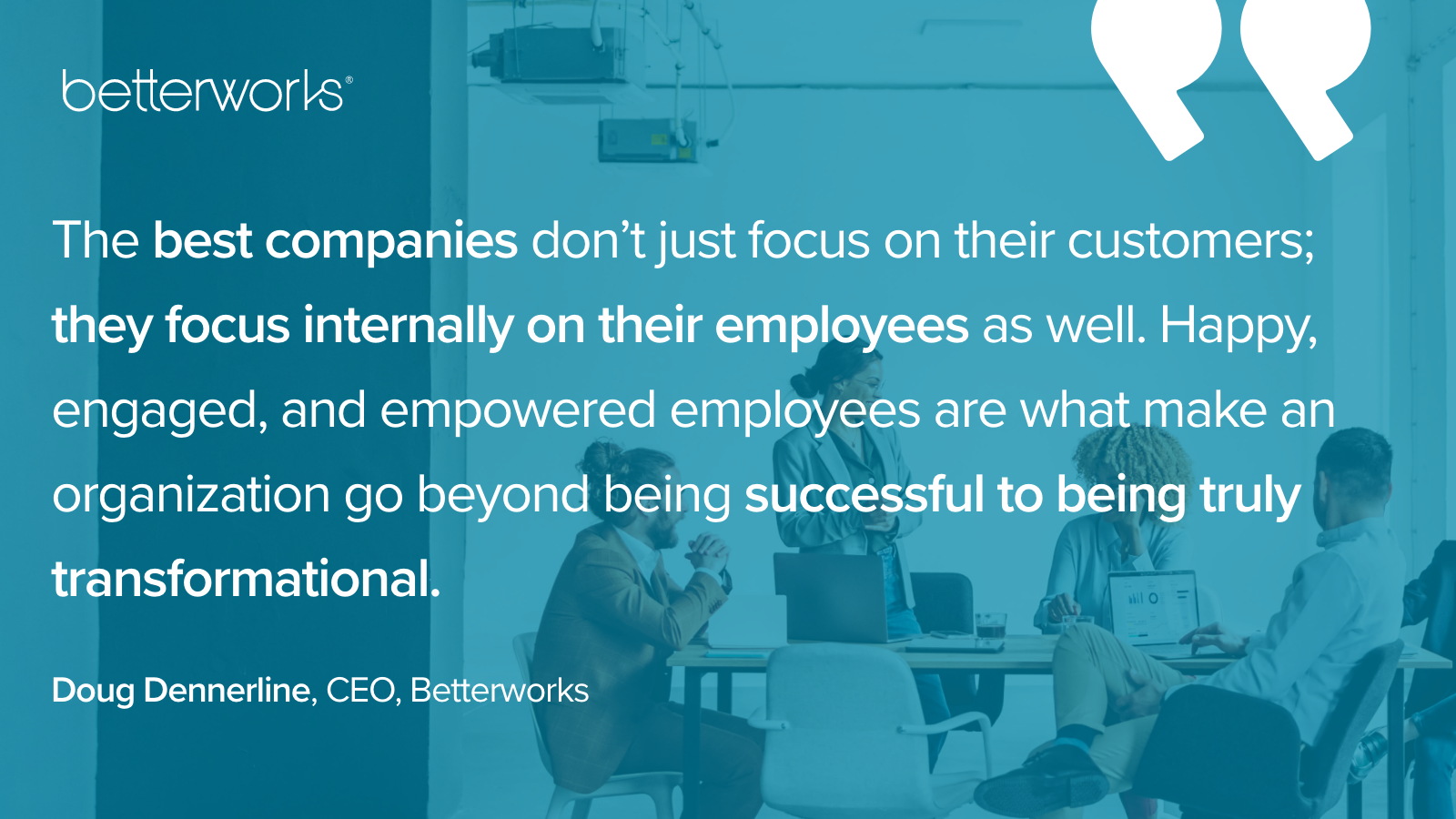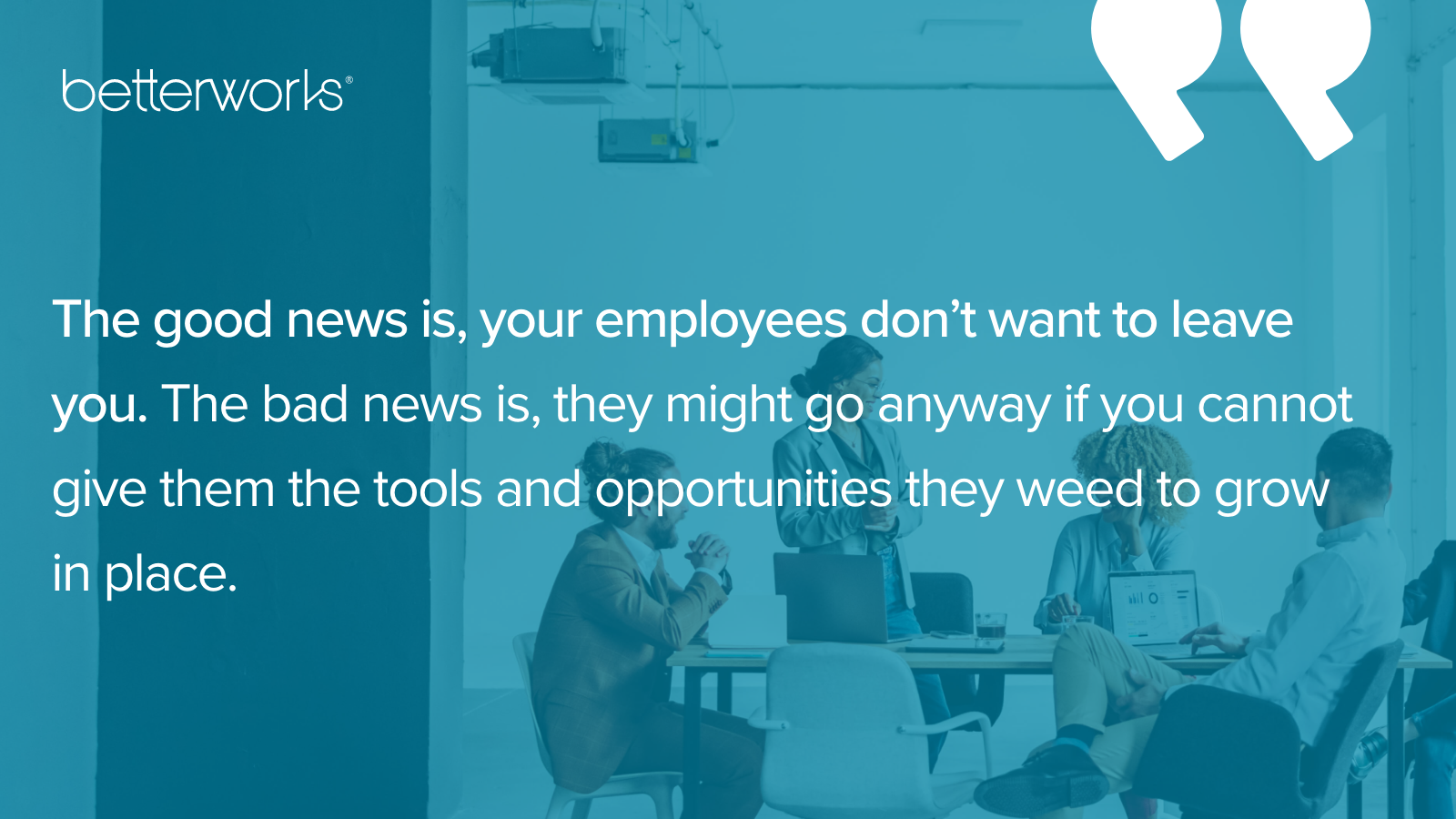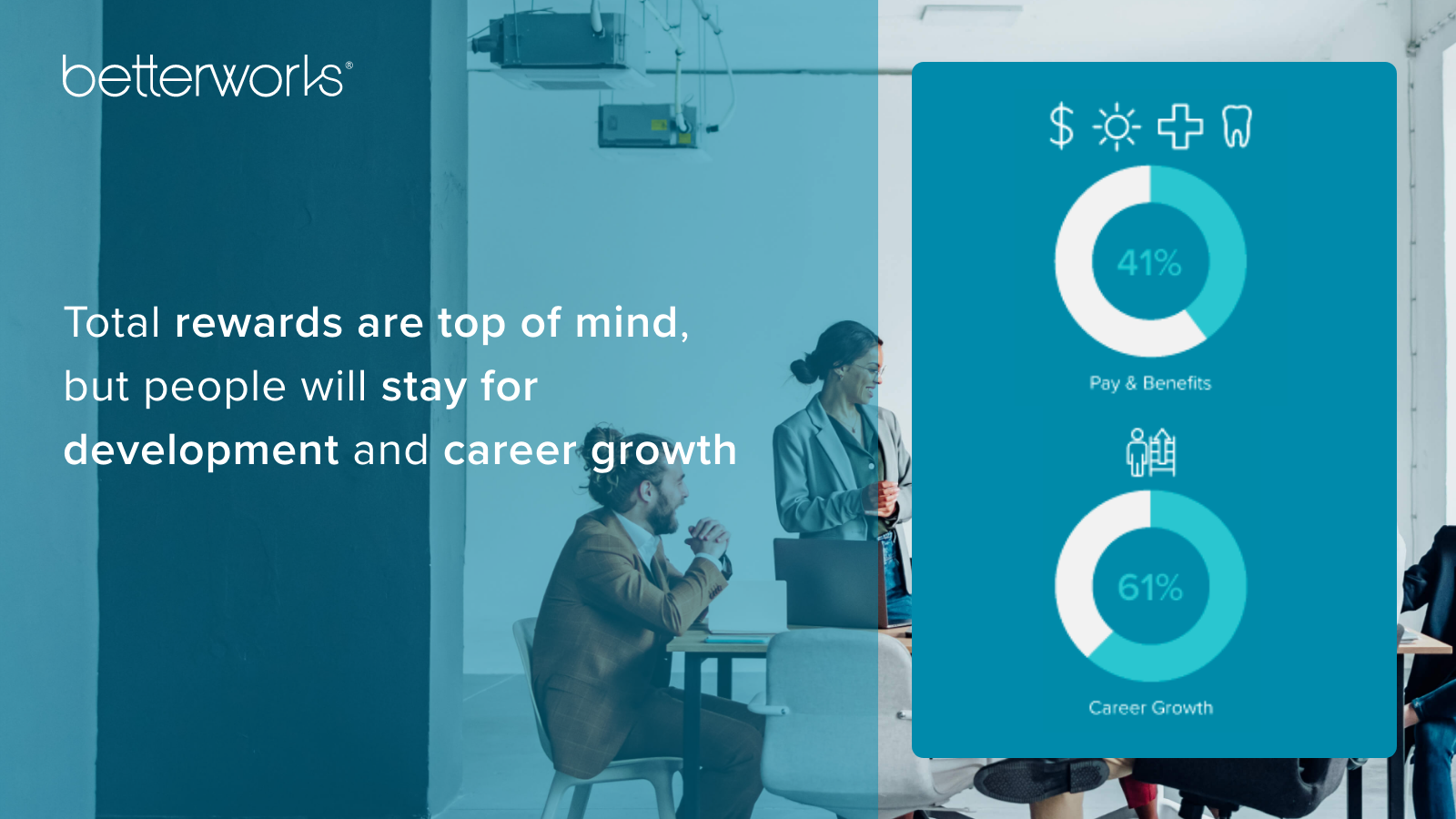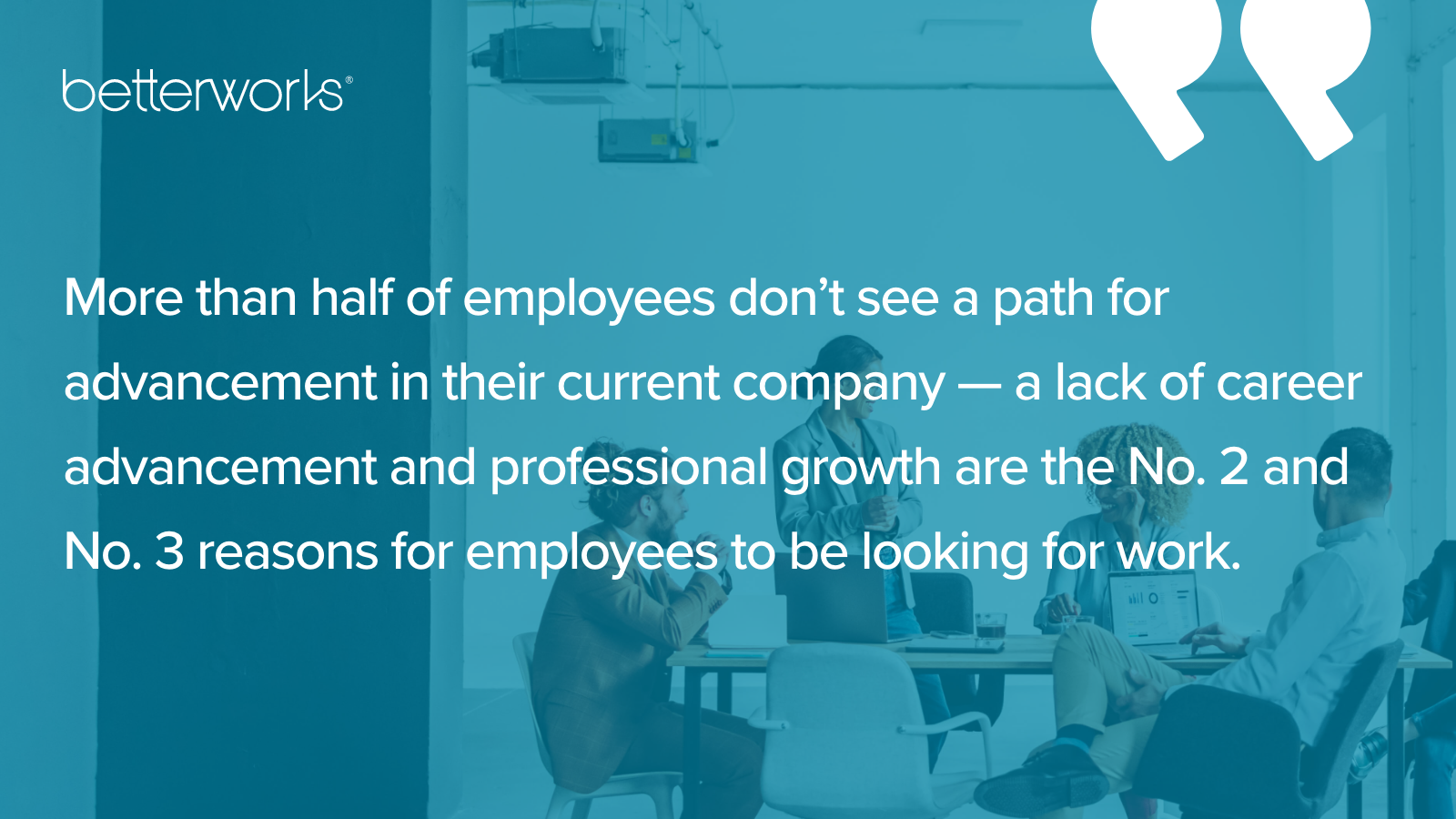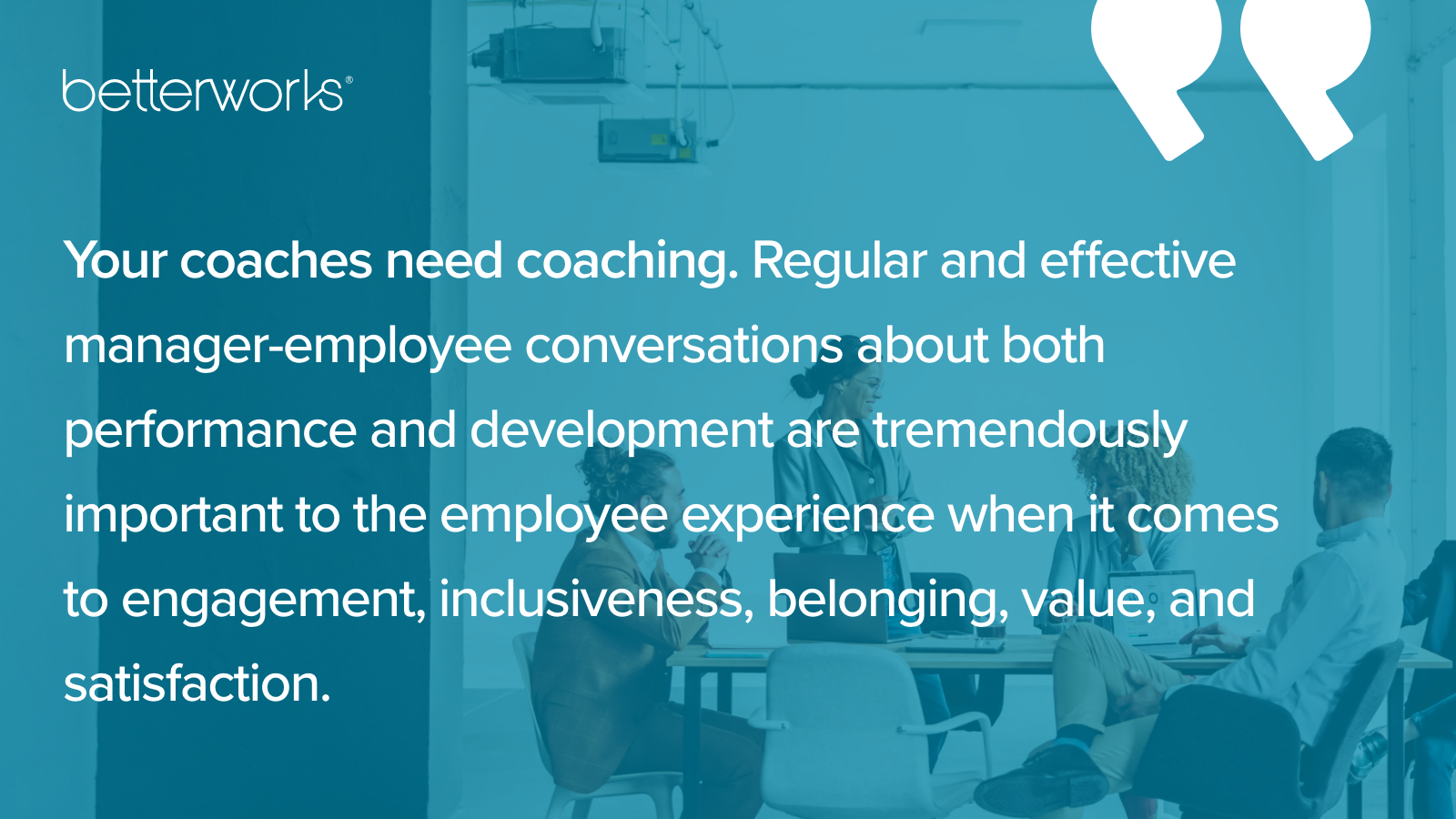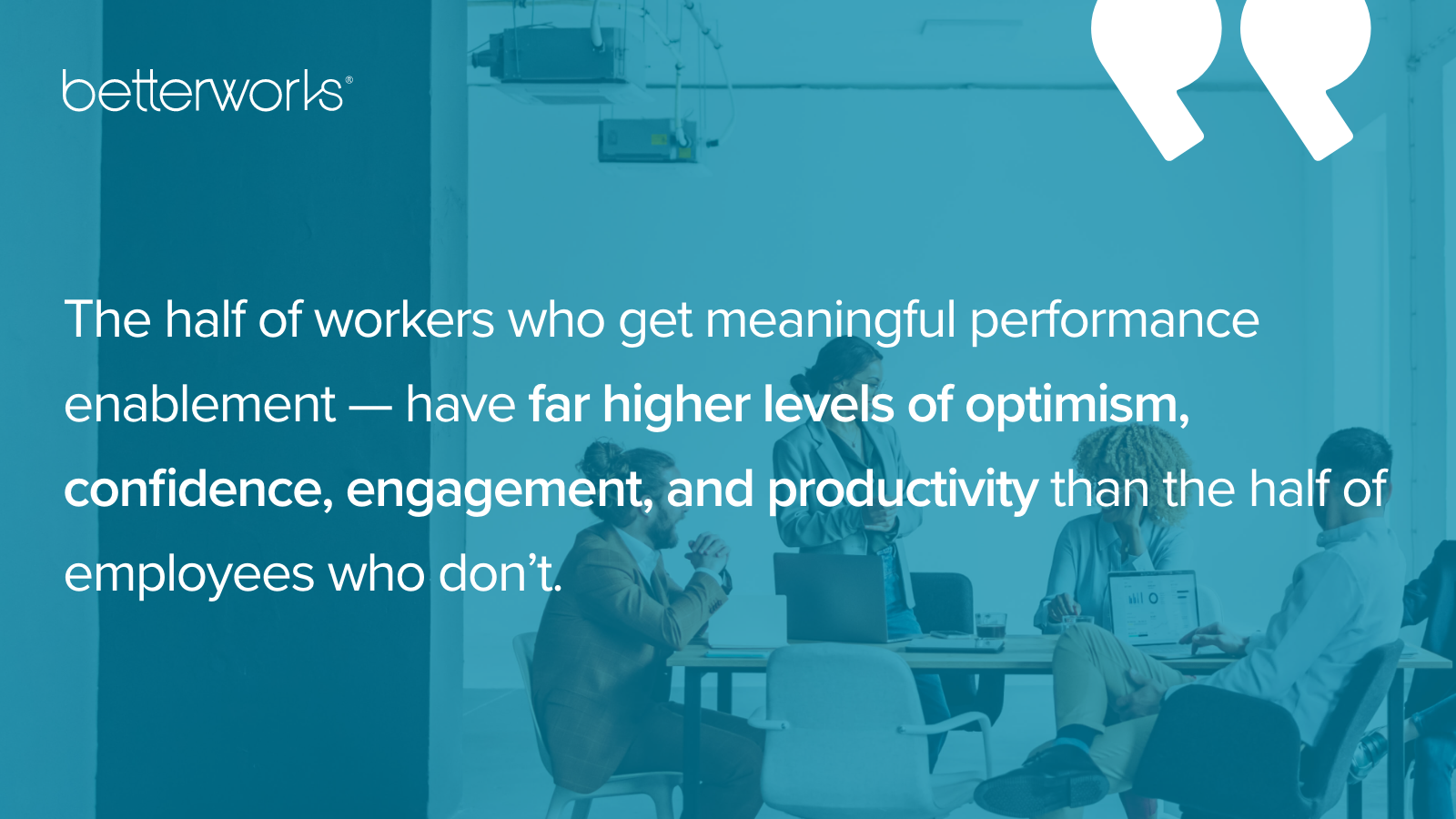The State Of Performance Enablement
Using Performance Enablement to Forge a Fairer Employee Deal
2023 State of Performance Enablement Report
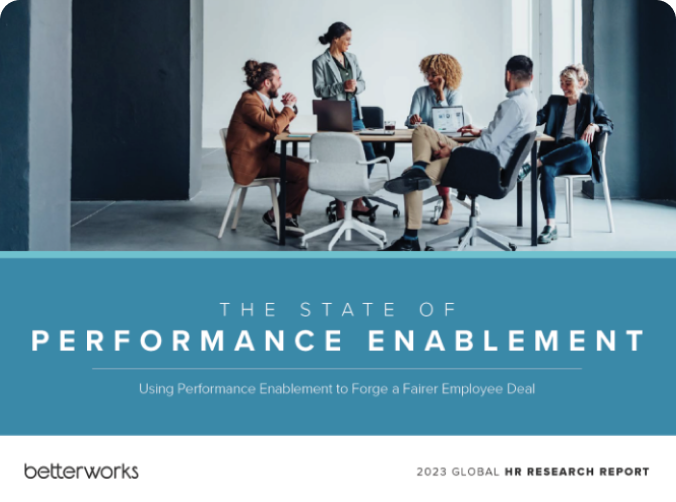
2,029 RESPONDENTS
50% IC’s, 31% Manager (non-HR), 13% Director or above, 5% HR manager or above

70% USA

30% United Kingdom

Fully-EmployedWorkers

1,000+ EE
Companies

Age & Gender Balanced

As HR and business leaders, we live in a uniquely exciting time. At no other point in modern history have we dealt with a confluence of forces in such a short period that are fundamentally changing the way we work and what we expect from it. The pandemic forever altered our perspectives on the importance of work in relation to our lives, what we value, and where and how we work. Concurrently, we are dealing with the need to up-level the employee experience, accelerate the development of a new generation of managers, and provide transparency to company leaders around a myriad of metrics — from workforce productivity to agility. Businesses are coping with how to upskill and reskill the workforce, accelerate digital transformation, and understand and assimilate a younger generation of workers with a different set of values. They must retain and attract talent in a competitive marketplace and a continually evolving business environment where success requires agility.
I know some of you may be thinking, “What? Addressing the challenges of the workforce and improving the employee experience has never been more complex, and I’m exhausted, not excited!”
I completely understand having taken Betterworks through this period as the CEO. But I want to challenge you to view all of this through a different lens. Yes, it’s been difficult to say the least. But you have the opportunity now — and I would say the privilege — to be bold, to lead your organization into the next frontier by helping evolve the way your people work into a far better state.

Our second annual State of Performance Enablement report is our effort to help us and you truly understand what matters to the workforce – what employees want, what enhances their experience of work and what diminishes it, why they leave, and why they stay. Six key findings came out of our research, and from these, we derived six key themes. Above all, we see that the employee deal — essentially, the employee value proposition — must be re-engineered. Employees feel they have given their all, especially since 2020, and they expect more from their employers in return. The employee deal comprises the explicit and implicit promises to employees, encompassing everything from total rewards to broader concepts such as fairness, inclusion, career care, purpose, and well-being.
The supporting themes fall under this overarching theme of delivering a better employee deal. Employers must respond to the desire for career growth and development if they wish to avoid the retention cliff — our second theme. Third, fairness matters greatly to employees and colors their entire experience. Feelings of bias in systems like performance management can undermine a multitude of other workforce sentiments, and fairness is sorely absent in performance reviews according to a majority of employees. Bias leads to mistrust, and as we explain in our fourth theme, trust in HR is at a low point. Organizations must be mindful of this gap. With the recent conversations about burnout, which put everyone at all levels at risk, businesses must double down on their efforts to relieve this pressure point. Nowhere is this more true than for managers. Our fifth theme is about better supporting managers by up-leveling performance and, especially, development coaching. Empowering your managers to coach will have an outsized impact on your organization. Lastly, we see that good performance enablement — which allows employees to create meaningful developmental and performance goals that align with their company’s strategic goals and equips managers to frequently coach and enable employees — has a multiplier effect on the organization. Employee feelings of productivity, confidence, engagement, optimism, focus, and relevance are higher across the board for employees who have tools that enable great performance.
It’s clear from our research and from third- party studies that the shift from traditional performance management to a contemporary solution —what we call performance enablement —is underway.
Now is the time to adapt, change, and grow to evolve and elevate the employee experience. The best companies don’t just focus on their customers; they focus internally on their employees as well. Happy, engaged, and empowered employees are what make an organization go beyond being successful to being truly transformational.
At Betterworks, we’ve been on a mission to enable great performance and improve the employee experience with best-in-class, consumer-grade technology that helps companies align, motivate, develop, and retain their people. I hope that this research provides you with the insights and data you need to move toward a human-centric way of operating. And I look forward to engaging in a rich conversation about how we can all make work better.
Executive Summary & Key Points
Growth, Enablement, and a Fairer Employee Deal
To meet the future of work, companies must help employees to see a clear and fair path for growth. This means reforging the employee deal and proactively enabling employees to develop their careers in place, ensuring that development is unbiased and elevating perceptions of inclusion.
Companies must focus on providing employees and managers with the skills and technology to talk not only about performance — but also their careers and long-term skill development. They must also try to eradicate the perceptions of bias and stagnancy that make employees feel less valued and drive them toward quitting — either quietly or loudly.
Disruption has become the new normal in the workplace (and all our lives), and 2023 is shaping up to be no different. The Great Reshuffle is still underway — powered not only by employee resignations but also by layoffs due to technology shifts, inflation worries, and a threat of recession. As we surveyed employees for this second annual performance enablement survey, many did say they are still looking for new jobs — but a majority said they would actually much prefer to develop and grow where they are.
Moreover, employees are stepping up their game. They are feeling positive about work and are more engaged and contributing at higher levels than last year. They are doing their part to help their teams succeed, but many are concerned about fairness in the system.
To retain these employees and help them deliver on their potential, companies must focus on a new and broader definition of the “employee deal.” That means crafting an employee value proposition (EVP) that includes not only traditional total rewards, but a modern performance management approach that reflects the needs of today’s workforce and embraces skills development and career pathing for tomorrow. Our data shows that cultivating a good employee experience must be laser-focused on fairness and belonging for companies to succeed.

The difference a year makes
We began this year’s survey by looking to see what had changed compared to our 2022 data. Although some continuity in the results remained, there were also notable changes. Employee intent to leave is roughly the same as it was last year: 14% of employees say they are actively seeking new work versus 13% in 2022. Still, overall, the momentum of the revolving door is slowing. Passive job searching has dropped significantly — to 9% versus 22% last year. There is an uptick in people who are waiting out the economy (6%) before they go, but there are more people who plan to stay in their current job (40%), and more people who are looking for advancement in their current company (17% versus 13% last year.)
What does all this mean? The good news is your employees don’t want to leave you. A majority of people like working for their companies. The bad news is they might go anyway if you cannot give them the tools and opportunities they need to grow in place.
Last year, we were still seeing a ‘pandemic effect’ in the reasons people stayed and went. After pay/benefits (43%), the most influential factors in changing jobs were stress/wellbeing (30%) and flexible work options (22%). Career advancement opportunities trailed in fourth place (20%).
This year, the focus on pay has increased even more than usual (51%) as the top reason for leaving a job. This is not surprising, given the concerns of a possible recession.
Our questions were slightly different this year, but we can still see how people have also shifted to a longer-term view. Flexibility, while still in the mix, has dropped to fifth place. Development concerns have ascended and are top-of-mind. Career advancement is the No. 2 reason people are thinking of leaving in 2023 (35%), followed by professional growth (34%) and wanting a better company culture (30%).
Employees are less vulnerable to poaching in 2023
- Yes, I’m open to recruitment by a new company: 22%
- 8%
Career growth is rising in importance in 2023
- Pay 43%
- 51%
- Flexible work options 22%
- 30%
- My career goals and purpose 20%
- 35%
- Company culture 20%
- 30%
OVERALL, WE SAW SIX MEANINGFUL THEMES
EMERGE FROM THIS YEAR’S DATA
The current employee deal needs to be reimagined
+The employee deal is about more than pay and rewards. It includes skills development, purpose, fairness, inclusion, culture, and more. It comprises the totality of the employee experience, including health and financial well- being and long-term career aspirations.
The employee deal has two sides to it, and employees feel they are working hard at delivering on theirs — giving their all and fulfilling their part of the “contract.” Employees’ assessment of their own productivity and engagement has significantly outpaced what we saw in 2022.
They’ve dealt with layoffs and re-assignments, readjusted to new ways of working, and borne stress and burnout, not just from work but from everything that has happened in the world in the past few years. They’ve persevered.
But as resilient and productive as they have been, they are not always seeing a return on what they’ve put into the system.
Employers have absolutely been working on trying to improve the system, too. Many employees have seen significant changes to their performance management processes and tools in the past two years. Anecdotally, we also have seen employers making real efforts with well-being programs, customized benefits, flexible work, and more. Employees generally really like working for their companies, and want to stay.
The employee deal is about more than pay and rewards. It includes skills development, purpose, fairness, inclusion, culture, and more.

Yet, workers are also showing frustration with the lack of options open to them. They believe their organizations are not providing adequate opportunities for growth and career advancement, and sometimes their managers — especially newer managers — are ill-equipped to help them. To keep them, employers must expand their vision for the employee deal. This includes showing workers a path for advancement and providing them with the tools and guidance to move internally
Emplyoees who answered that they Always Go Above and Beyond
Avoiding the retention cliff requires focusing on career development
+First, the good news. The preference for employees seems to be growing where they are planted, over job-hopping. Overall, this year, a majority (75%) of people said they would rather stay with their company to advance in their careers. It’s worth noting that this is true at all ages — for Gen Z and Millennials as for older workers. In both of those cohorts, 72% said they would prefer to advance in their current companies, versus 77% of those 45-60 and 78% of those over 60.
Now, the tougher news. Even though most employees want to stay, if the organization fails to live up to the employee deal, those employees will leave anyway. More than half of employees don’t see a path for advancement in their current company — and career advancement and professional growth are the #2 and #3 reasons for employees to be looking for work.
When we asked employees who may leave what would help them decide to stay with their company, pay and benefits predictably topped the list. And, here again, career took the #2 spot. This year’s respondents cited internal career opportunities (41%) and better skills development (36%) as their other top reasons for staying.

With continued low unemployment rates and stiff competition for the most skilled talent, companies are in danger of losing talented employees if they can’t deliver on the promise of career growth and advancement.
Total rewards are top of mind, but people will stay for development and career growth
Fairness matters – it colors the employee experience
+This year’s data also showcases the growing importance of the relational and social factors of work. People want to feel they are part of something bigger than themselves — valued, recognized, and treated fairly — as well as on the road to a brighter future. Fairness, good culture, and team support were all themes that bubbled up in this year’s data.
Fairness was one theme that stood out. This year’s data shows that many employees feel performance reviews are not entirely fair, mainly due to inadequate feedback from people the employee works with day in and day out. Most people work in teams or in cross-functional, matrixed organizations. A manager is best served by having a complete picture of an employee and their performance through the feedback of team members and other colleagues.
When employees feel they are not being treated fairly, there is a knock-on effect on productivity and engagement — resulting in the long-standing phenomenon that has recently been coined as “quiet quitting.” In many ways, this is a self-inflicted wound, albeit often unintentional, for companies. But it’s fixable, and organizations that address feelings of fairness will have more success in retaining talent and ensuring their people stay engaged, happy, and productive.
When employees feel they are not being treated fairly, there is a knock-on effect on productivity and engagement — resulting in the long-standing phenomenon that has recently been coined as “quiet quitting.”

HR must mind the trust gap
+Concerns about fairness have a reciprocal relationship with trust — as bias in the system can affect trust in leaders and vice versa. Trust has stagnated — and once eroded, it can be diffcult to rebuild. In 2023, employee levels of trust are at a dangerously low ebb. The upside is that many employees report high trust in their managers. Still, three in ten don’t trust team members or managers, and about seven in ten don’t trust leaders or HR. Ten percent of employees don’t trust anyone at all.
Low trust is not a big surprise. According to multiple other studies, trust in HR and leadership were low prior to the pandemic. But they may be disappointing to read, nonetheless, given how organizations have been working to elevate the employee experience and shifting their values toward stakeholder — rather than shareholder—value.
This is a snapshot in time. Distrust may still be high due to economic uncertainty, or it may simply be that stakeholder-focused initiatives, such as those around employee well-being, have yet to be fully realized. With continued good-faith efforts to support employees and managers and to make performance management systems fairer, HR and company leaders can forge higher employee trust. This can assure employees that leaders and HR — often the custodians of the performance process — are working in their best interests.

With continued good-faith efforts to support employees and managers and to make performance management systems fairer, HR and organizational leaders can forge higher employee trust.
Accelerating manager effectiveness through coaching and resources is vital
+
Managers are the linchpin that holds your organization together. This year’s analysis reveals that employees trust their managers as much as their teammates. Nine out of ten people said they always or sometimes like working for their manager — with 48% saying ‘always.’ A strong plurality believes managers care about their progress and are trying to be a help to their careers. But managers — especially inexperienced ones — are ill-equipped when it comes to coaching for growth and career development. And employees will leave if they see no path for career advancement. The bottom line: your coaches need coaching.
Regular and effective manager-employee conversations about both performance and development are tremendously important to the employee experience when it comes to engagement, inclusiveness, belonging, value, and satisfaction. This is significant because half of employees (49%) also told us they’ve considered leaving a job because their manager was bad at giving feedback or reviews. There is also enormous potential for organizations to use managers to promote career and skills development, but most companies do not appear to be leveraging them to capacity.
To effectively take advantage of the relationships managers have built with employees — and to better support those relationships over the long term — HR must provide managers with more training and tools to coach for skills and career development, not just performance.
Good performance enablement has a multiplier effect
+Rethinking your performance management today will have a multiplier effect, yielding far better sentiments and outcomes across your organization.
Employees want performance enablement to help them increase their effectiveness and grow their careers. The half of workers who get meaningful performance enablement — including goal-setting and tracking, feedback, and purposeful and ongoing conversations — have far higher levels of optimism, confidence, engagement, and productivity than the half of employees who don’t. Among the latter group, two-thirds want adequate performance enablement.
Some of this comes down to the tools companies use. Those tools must be lightweight, dedicated, and easy to use in the flow of work to be useful for both performance and development. Otherwise, employees use them only once or twice a year for performance reviews, rendering these tools largely ine ective when it comes to continuous performance improvement.
The data in this report makes clear how acutely performance enablement affects sentiment, well-being, and feelings of mastery and autonomy. Good enablement is a transformational approach that changes the way employees feel about their work, purpose, efforts, interests, and feelings of belonging. The effects are synergistic. A performance enablement mindset has the ability to change hearts and minds, as well as bottom lines. It’s a new way of thinking about how we view our people — one that connects people, promotes collaboration, values employees, and elevates the employee experience.
Let’s dig into the findings.




